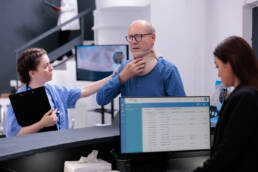The Silent Threat of Sitting Disease
In the heart of Redmond, WA, where innovation and progress thrive, there exists a silent threat that often goes unnoticed amidst the hustle and bustle of everyday life—the perils of prolonged sitting. As a chiropractor deeply rooted in this vibrant community, I’ve seen how our modern lifestyles, predominantly desk-bound and sedentary, have silently ushered in a health epidemic known as “Sitting Disease.”
Picture this: the countless hours spent hunched over desks, engrossed in work or glued to screens, the lengthy commutes where we remain seated for extended periods, and the evenings spent relaxing on the couch. These seemingly innocuous activities collectively contribute to a health crisis that affects us more profoundly than we realize.
Unveiling the Dangers of Sedentary Living
“Sitting Disease” isn’t merely a catchphrase; it’s a legitimate concern backed by scientific evidence. Studies reveal that individuals who spend a significant portion of their day sitting are at a higher risk of developing a myriad of health issues. From the seemingly innocuous back discomfort that morphs into chronic pain to the subtle changes in our metabolism that pave the way for obesity and metabolic disorders, the repercussions of prolonged sitting are far-reaching.
But it doesn’t stop there. The impact of Sitting Disease transcends physical health. It affects our mental well-being, contributing to increased stress levels, anxiety, and a sense of fatigue that lingers despite hours of rest.
Empowering Change: A Call to Action
However, amidst these sobering facts lies hope and the potential for change. As a chiropractor committed to the well-being of the Redmond community, I’m passionate about shedding light on Sitting Disease and guiding individuals toward a path of resilience and vitality.
This blog isn’t just a compilation of facts; it’s a beacon of empowerment. It’s a call to action to reclaim control over our health, to challenge the norms of our sedentary culture, and to embrace a lifestyle that promotes movement and vitality.
Embracing Solutions for a Healthier Tomorrow
Throughout this article, we’ll explore actionable strategies—simple yet impactful changes that anyone can incorporate into their daily routine. These solutions encompass more than merely standing up or taking breaks; they encompass a holistic approach that nurtures our bodies, minds, and spirits.
By understanding the intricacies of Sitting Disease and adopting proactive measures, we can break free from its shackles. Together, we’ll discover how regular movement, ergonomic practices, exercise routines, and the guidance of chiropractic care can pave the way toward a pain-free, healthier life.
Join me in this journey toward a future where Sitting Disease is no longer a prevalent threat but a conquered challenge—a future where the Redmond community thrives in health, vitality, and well-being.
Move Regularly: A Prescription for Health
In a world dominated by sedentary tasks, the simple act of moving regularly holds immense power in preserving our health and vitality. Incorporating movement into our daily routine isn’t just a suggestion; it’s a vital prescription for our well-being.
1. Breaks for Body and Mind
Every 30 minutes, take a moment to stand up, stretch, or perform a quick walk around your workspace. These breaks not only alleviate physical strain but also rejuvenate your mind, enhancing productivity and focus. Use this time to indulge in simple stretches, shoulder rolls, or even a brief walk to the water cooler. Small intervals of movement, scattered throughout the day, can work wonders in preventing stiffness and improving circulation.
2. Revamp the Routine
Introduce micro-exercises into your schedule.* Whether it’s opting for the stairs instead of the elevator, doing calf raises while waiting for the kettle to boil, or performing desk exercises during short breaks, infusing these micro-movements can add up significantly over time. Seize every opportunity to incorporate physical activity into your daily tasks.
3. Leverage Technology
Set reminders or use apps that encourage movement. With the aid of technology, you can establish regular intervals for movement breaks. Consider utilizing apps or smartwatch features that notify you to stand or stretch at designated intervals, ensuring that you remain mindful of your movement goals throughout the day.
4. Mindful Movement Practices
Incorporate mindful movement practices into your routine. Activities such as yoga, tai chi, or Pilates not only encourage physical mobility but also promote mental relaxation. These practices blend gentle movement with conscious breathing, serving as a holistic approach to counteract the effects of prolonged sitting.
5. Socialize and Move
Engage in active social interactions. Instead of coffee meetings at a desk, opt for walking meetings. Not only does this promote movement, but it also fosters creativity and enhances collaboration. Additionally, consider joining fitness classes or group activities with friends or colleagues as a way to combine socializing with physical activity.
6. Stay Hydrated and Mobile
Use hydration breaks as a cue to move. Frequent hydration is beneficial for your health, and it can also serve as a prompt to stand up and move. Use these breaks to stretch, walk, or perform simple exercises, effectively breaking up prolonged periods of sitting.
Creating an ergonomic workstation is pivotal in mitigating the adverse effects of prolonged sitting. Here’s an expanded section focusing on optimizing workspaces for better posture and overall health:
Ergonomic Workstations: Crafting Your Health-Focused Workspace
The way we set up our workstations profoundly impacts our posture, comfort, and ultimately, our health. An ergonomic workspace isn’t just about aesthetics; it’s about fostering an environment that supports our bodies and minimizes the strain imposed by extended periods of sitting.
1. Customize Your Setup
Invest in an adjustable chair and desk. Ensure that your chair provides proper lumbar support and can be adjusted to maintain a neutral posture. Your desk should allow for flexibility in height to accommodate both sitting and standing positions. Adjustable desks, commonly known as sit-stand desks, offer the versatility needed to alternate between sitting and standing throughout the day.
2. Optimal Screen Positioning
Position your monitor at eye level. Your computer screen should be directly in front of you, at arm’s length, and at eye level to prevent straining your neck or eyes. Use monitor stands or adjust the height accordingly to achieve the ideal positioning.
3. Ergonomic Accessories
Consider ergonomic accessories. Invest in accessories like an ergonomic keyboard and mouse to maintain a neutral wrist position and reduce the risk of repetitive strain injuries. Utilize footrests if needed to support proper posture and reduce pressure on your lower back and legs.
4. Organize Your Workspace
Keep frequently used items within reach. Arrange your workstation so that essential items like your phone, notepads, or stationery are easily accessible without straining or overreaching. This prevents unnecessary twisting or awkward postures that can lead to discomfort.
5. Mindful Sitting Habits
Maintain proper sitting posture. Sit with your back against the chair and your feet flat on the floor or on a footrest. Ensure that your knees are at or slightly below the level of your hips. Avoid crossing your legs for extended periods as it can impair circulation and strain your back.
6. Take Advantage of Breaks
Utilize standing or movement breaks. When using a sit-stand desk, alternate between sitting and standing positions throughout the day. Remember to adjust your desk and chair properly in each position to maintain ergonomic alignment.
7. Regular Adjustments and Assessments
Regularly reassess and adjust your setup.* As your work habits or needs change, make corresponding adjustments to your workstation. Periodically evaluate your posture and ergonomics to ensure that your setup continues to support your health and comfort.
Exercise Routine: Revitalize Your Body Through Movement
In a sedentary world, exercise emerges as the beacon of vitality, offering a pathway to counteract the adverse effects of prolonged sitting. Engaging in regular physical activity isn’t just beneficial; it’s essential for maintaining overall health, mobility, and resilience against Sitting Disease.
1. Aim for Consistency
Commit to a regular exercise regimen. Schedule dedicated time for physical activity throughout the week. Aim for a mix of cardiovascular exercises, strength training, and flexibility-enhancing routines to achieve a well-rounded workout plan.
2. Cardiovascular Exercises
Embrace aerobic activities. Engage in exercises that elevate your heart rate, such as brisk walking, jogging, cycling, swimming, or dancing. These activities boost circulation, improve cardiovascular health, and counteract the effects of prolonged sitting on your body.
3. Strength Training
Incorporate resistance exercises. Strength training, whether with weights or bodyweight exercises, helps build and maintain muscle strength. Focus on exercises targeting major muscle groups, such as squats, lunges, push-ups, and deadlifts, to improve posture and support spinal health.
4. Flexibility and Mobility Work
Prioritize flexibility exercises. Stretching and mobility exercises enhance flexibility, alleviate muscle tension, and promote better posture. Activities like yoga, Pilates, or dedicated stretching routines are invaluable in combating the muscular stiffness resulting from prolonged sitting.
5. Interval Training and Active Breaks
Introduce interval training or active breaks. High-intensity interval training (HIIT) or short bursts of intense activity followed by brief periods of rest can be highly effective in a limited timeframe. Additionally, take advantage of breaks during the workday for short, active movements like jumping jacks, lunges, or squats.
6. Outdoor Activities and Recreation
Explore outdoor activities. Hiking, cycling, or playing recreational sports not only provide physical exercise but also offer mental rejuvenation by connecting with nature and fostering a sense of well-being.
7. Consistency and Progression
Gradually increase intensity and duration. As your fitness improves, progressively challenge yourself by increasing the intensity or duration of your workouts. However, always listen to your body and avoid overexertion or pushing beyond your limits.
Chiropractic Care: Restoring Alignment and Mobility
In the quest to combat the repercussions of a sedentary lifestyle, chiropractic care emerges as a beacon of holistic healing, offering a specialized approach to alleviate discomfort and restore the body’s natural balance. Prolonged sitting takes a toll on our bodies, particularly our spinal health, and seeking chiropractic care becomes pivotal in mitigating these effects.
1. Spinal Realignment
Addressing spinal misalignments. Extended periods of sitting often lead to poor posture and spinal misalignments, resulting in discomfort and reduced mobility. Chiropractic adjustments aim to realign the spine, restoring proper alignment and function, thereby alleviating pain and improving overall mobility.
2. Relief from Muscular Tension
Alleviating muscular tension and stiffness. Sedentary lifestyles contribute to muscle stiffness and tension, especially in the back, neck, and shoulders. Chiropractic care incorporates targeted adjustments and soft tissue techniques to relieve muscular tension, promoting relaxation and flexibility.
3. Enhancing Joint Mobility
Improving joint mobility and function. Prolonged sitting often restricts joint mobility, leading to reduced range of motion. Chiropractic adjustments aid in restoring proper joint function, enhancing mobility, and preventing joint degeneration caused by immobility.
4. Postural Correction
Addressing postural imbalances. Hours spent in front of screens can lead to postural imbalances, contributing to discomfort and pain. Chiropractors assess and correct postural imbalances, providing guidance on ergonomic adjustments and exercises to support proper posture.
5. Preventive Care and Wellness
Embracing preventive care for long-term wellness. Beyond addressing immediate discomfort, chiropractic care emphasizes preventive measures to maintain spinal health. Regular adjustments and personalized wellness plans aid in preventing future issues and fostering overall well-being.
6. Tailored Treatment Plans
Personalized treatment approaches. Chiropractors create individualized treatment plans tailored to each patient’s needs. These plans may include adjustments, exercises, lifestyle recommendations, and ergonomic advice to address specific concerns stemming from prolonged sitting.
7. Collaborative Care Approach
Integration with a holistic approach to health. Chiropractors often collaborate with other healthcare professionals to provide a comprehensive approach to wellness. This integration may involve recommendations for exercise routines, nutrition, and stress management techniques to support overall health.
Embracing a Healthier Lifestyle: Beyond Sitting Disease
Combatting Sitting Disease requires more than isolated interventions; it calls for a holistic transformation in lifestyle. Embracing a healthier way of living involves consciously integrating movement, nutrition, mental well-being, and self-care practices into our daily lives.
1. Movement as a Habit
Make movement a non-negotiable part of your day. Beyond scheduled exercise sessions, infuse movement into everyday activities. Take the stairs instead of the elevator, walk or bike for short errands, or incorporate active hobbies into your leisure time. Cultivate a mindset that values and prioritizes movement.
2. Nourish Your Body
Adopt a balanced and nourishing diet. Opt for whole, nutrient-dense foods that fuel your body and support overall health. Incorporate fruits, vegetables, lean proteins, whole grains, and healthy fats into your meals while minimizing processed and sugary foods.
3. Mind-Body Connection
Nurture mental and emotional well-being. Practice mindfulness, meditation, or deep-breathing exercises to reduce stress levels and promote mental clarity. Engage in activities that bring joy and relaxation, whether it’s reading, painting, or spending time in nature.
4. Prioritize Rest and Recovery
Ensure adequate rest and quality sleep. Establish a consistent sleep routine that allows for sufficient restorative sleep. Quality sleep supports physical recovery, mental alertness, and overall well-being.
5. Hydration and Self-Care
Stay hydrated and prioritize self-care. Hydration is essential for optimal body function. Incorporate self-care practices such as regular massages, warm baths, or stretching routines to relax muscles and alleviate tension.
6. Social Connection and Support
Cultivate supportive social connections. Surround yourself with individuals who encourage healthy habits and provide positive support. Engage in social activities that promote movement and well-being, fostering a sense of community and belonging.
7. Continual Learning and Growth
Embrace continual learning and personal growth. Stay curious and open to new experiences. Engaging in learning activities, whether through books, workshops, or classes, fosters mental stimulation and personal development.
A Journey Towards Vibrant Health and Well-Being
The battle against Sitting Disease isn’t a mere skirmish—it’s a transformative journey toward reclaiming our health, vitality, and joy in life. As we conclude this exploration, remember that every step taken toward a healthier lifestyle is a stride toward a brighter, pain-free tomorrow.
Uniting Forces Against Sitting Disease
The awareness garnered through this journey has shed light on the silent dangers of prolonged sitting. We’ve unveiled the adverse effects on our bodies—muscular tension, reduced mobility, and the silent erosion of our well-being. But armed with knowledge, we stand prepared to confront these challenges head-on.
Holistic Empowerment
Embracing a healthier lifestyle isn’t about instant remedies; it’s about holistic empowerment. It’s about integrating movement into our daily routines, nourishing our bodies with wholesome foods, fostering mental clarity and emotional balance, and prioritizing self-care as a non-negotiable aspect of our lives.
The Power of Small Steps
It’s crucial to recognize that every small step toward a healthier lifestyle holds immense power. Whether it’s opting for the stairs, savoring a nutritious meal, taking a moment to meditate, or scheduling time for self-care, each action contributes to our overall well-being.
The Promise of Transformation
By committing to these changes, we aren’t merely alleviating the discomfort of Sitting Disease; we’re embracing a profound transformation—a life brimming with vitality, resilience, and profound well-being. It’s a life where movement is celebrated, where nourishment fuels our bodies, and where mental clarity ignites our passions.
Together Towards Wellness
Remember, this journey isn’t solitary; it’s a collective effort toward wellness. Together, as a community in Redmond and beyond, we can support each other, share our triumphs and challenges, and inspire one another to embrace a healthier, more fulfilling life.
Embrace the Journey
So, let’s embrace this journey with vigor and determination. Let’s continue exploring, learning, and growing. Let’s celebrate every small victory, knowing that each step taken brings us closer to a life unrestrained by the shackles of Sitting Disease.
Your Future of Vibrant Health Awaits
The road to vibrant health and well-being is before us. It’s a road illuminated by movement, nourishment, mindfulness, and self-care. Let’s step onto this path with conviction, for on the other side awaits a future where pain gives way to freedom, and where vitality becomes our daily companion. Contact us today.

Ready for an expert opinion? Get in touch today!
Chiropractic care in Redmond offers a holistic approach to health and well-being. Through gentle adjustments, personalized treatment plans, and patient education, chiropractors aim to improve spinal alignment, relieve pain, enhance performance, and promote overall wellness.
Like this article? Spread the word!
Related Posts
December 27, 2023
Unlocking the Secrets of Ergonomics: Building a Pain-Free Workspace for Neck and Back Health
Discover practical tips and exercises for neck and back health at Structural Chiropractic…
February 16, 2023
Top 5 Benefits of Auto Injury Chiropractic Services
There are so many different ways you can get injured while being involved in a car…
October 27, 2015
Whiplash: Don’t Crack That Whip!
Many people hear the term "Crack that whip" or "Whip It" and get a certain song in our…




